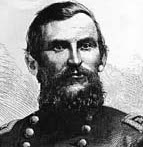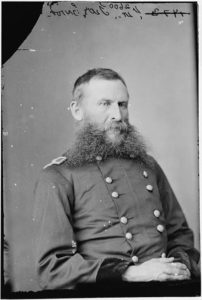E.C. Allen to President J.K. Polk (1849)
19 December 2022
Young Ebenezer Clough Allen was desperate to become a professional soldier but his parents wouldn’t let him enlist for war with Mexico in 1847. He applied to the Secretary of War in January 1848 for a spot at West Point, but was not appointed. In November 1848 he wrote President James K Polk for help. Still no luck. Persistent, he wrote the President again in February 1849 – an emotional and sincere 3 page missive asking for a direct appointment to the Academy.
There’s no response from the President in the file in the US Archives with his letter, but you’ll not be surprised to know the result was the same: no appointment.
The next year Ebenezer enlisted as a Private in the 3rd United States Infantry. He continued in the Army with some success to 1862, by which time he was First Sergeant of Company A, First Battalion, 12th United States Infantry. He was appointed 2nd Lieutenant of his Company in June 1862.
Lieutenant Allen commanded Company A in action at Antietam on 17 September 1862 and was with them at Fredericksburg in December, was promoted to First Lieutenant in January 1863, and was at Chancellorsville in May. He was afterward ill, and died of small pox in December 1863 after 13 years as a professional soldier.
Dagger and sheath (c. 1860)
19 December 2022
At the New York Historical Society.
handwritten in ink: on tag attached to object: Dagger picked / up on battlefield / during Battle of / Antietam / by Col. May H. / Stacey
Then-Lieutenant May Humphrey Stacey was Adjutant of the First Battalion, 2nd United States Infantry at Antietam.
George Crook (c. 1865)
16 December 2022
I’ve just been updating the previously skeletal Antietam on the Web profile for Colonel George Crook (USMA 1852) who commanded a brigade in the Kanawha Division of the US Ninth Army Corps at Antietam on 17 September 1862. In addition to new text I needed a better picture of him than this muddy etching:
I was pleased to find a wartime photo of him I’d not seen before; it was donated to the Library of Congress by Tom Liljenquist in 2021.
If you’re like me, you may be a little surprised by this relatively young face – expecting instead to see this one (also from the Library of Congress):
Keep in mind Crook had just turned 34 years old in September 1862 and the third picture, one most often associated with him in print and online, was taken 15 or more years later in the 1870s when he was in his late 40s/early 50s. Crook is far more famous for his post-war Indian fighting career, so it makes sense that that’s the face we usually see.
I came back to Colonel Crook yesterday after finding a photograph of Captain Samuel L Christie, the staff officer of the Kanawha Division at Antietam who delivered orders to Crook for his brigade to assault the lower bridge over the Antietam Creek that morning. Crook’s later description of that meeting captures something of his personality and the sometimes absurd nature of war:
About ten a.m. Capt. Christ [sic] on Gen. Cox’s staff came to see me, and said, ‘The General wishes you to take the bridge.’ I asked him what bridge. He said he didn’t know. I asked him where the stream was, but he didn’t know. I made some remarks not complimentary to such a way of doing business, but he went off, not caring a cent.
Thanks to Kevin Pawlak for that quote [Emerging Civil War post], which he found in Martin F. Schmitt’s General George Crook: His Autobiography (1946).
To finish the Burnside Bridge story, Colonel Crook wrote in his after-action report of 20 September
I received orders from the general commanding corps to cross the bridge over Antietam Creek after General Sturgis had taken the bridge; but upon my arrival in the vicinity of the bridge I found that General Sturgis’ command had not arrived; so I sent the Eleventh Regiment ahead as skirmishers in the direction of the bridge, and conducted the Twenty-eighth Regiment above the bridge to reconnoiter the enemy’s position, leaving the Thirty-sixth Regiment as reserve. After a labor of two hours, I succeeded in establishing two pieces of Simmonds’ battery in a position to command the bridge and getting five companies of the Twenty-eighth across the stream. I then intended taking the bridge with the Thirty-sixth Regiment, but soon after my battery opened on the bridge General Sturgis’ command crossed the bridge.







